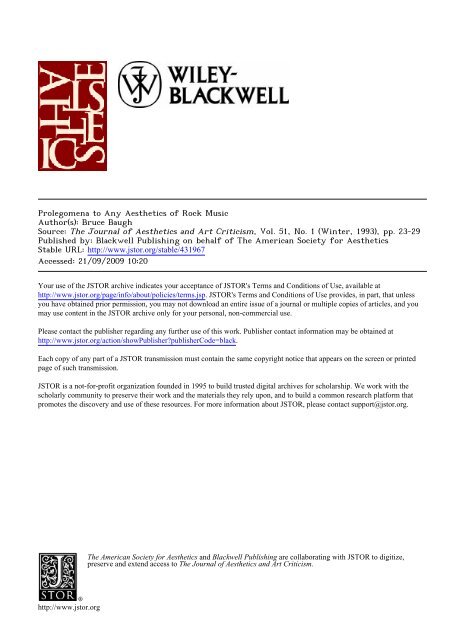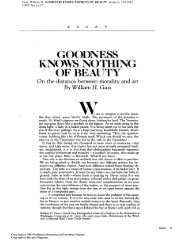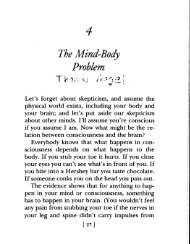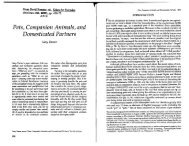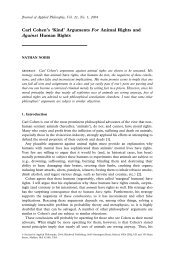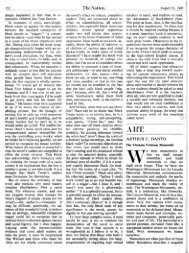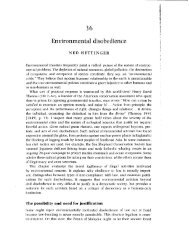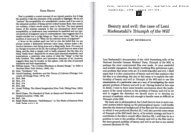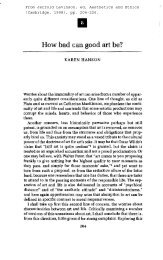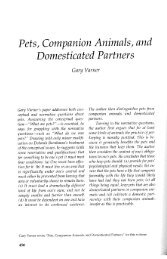Bruce Baugh, "Prolegomena to Any Aesthetics of Rock Music"
Bruce Baugh, "Prolegomena to Any Aesthetics of Rock Music"
Bruce Baugh, "Prolegomena to Any Aesthetics of Rock Music"
Create successful ePaper yourself
Turn your PDF publications into a flip-book with our unique Google optimized e-Paper software.
<strong>Prolegomena</strong> <strong>to</strong> <strong>Any</strong> <strong>Aesthetics</strong> <strong>of</strong> <strong>Rock</strong> MusicAuthor(s): <strong>Bruce</strong> <strong>Baugh</strong>Source: The Journal <strong>of</strong> <strong>Aesthetics</strong> and Art Criticism, Vol. 51, No. 1 (Winter, 1993), pp. 23-29Published by: Blackwell Publishing on behalf <strong>of</strong> The American Society for <strong>Aesthetics</strong>Stable URL: http://www.js<strong>to</strong>r.org/stable/431967Accessed: 21/09/2009 10:20Your use <strong>of</strong> the JSTOR archive indicates your acceptance <strong>of</strong> JSTOR's Terms and Conditions <strong>of</strong> Use, available athttp://www.js<strong>to</strong>r.org/page/info/about/policies/terms.jsp. JSTOR's Terms and Conditions <strong>of</strong> Use provides, in part, that unlessyou have obtained prior permission, you may not download an entire issue <strong>of</strong> a journal or multiple copies <strong>of</strong> articles, and youmay use content in the JSTOR archive only for your personal, non-commercial use.Please contact the publisher regarding any further use <strong>of</strong> this work. Publisher contact information may be obtained athttp://www.js<strong>to</strong>r.org/action/showPublisher?publisherCode=black.Each copy <strong>of</strong> any part <strong>of</strong> a JSTOR transmission must contain the same copyright notice that appears on the screen or printedpage <strong>of</strong> such transmission.JSTOR is a not-for-pr<strong>of</strong>it organization founded in 1995 <strong>to</strong> build trusted digital archives for scholarship. We work with thescholarly community <strong>to</strong> preserve their work and the materials they rely upon, and <strong>to</strong> build a common research platform thatpromotes the discovery and use <strong>of</strong> these resources. For more information about JSTOR, please contact support@js<strong>to</strong>r.org.The American Society for <strong>Aesthetics</strong> and Blackwell Publishing are collaborating with JSTOR <strong>to</strong> digitize,preserve and extend access <strong>to</strong> The Journal <strong>of</strong> <strong>Aesthetics</strong> and Art Criticism.http://www.js<strong>to</strong>r.org
BRUCE BAUGH<strong>Prolegomena</strong> <strong>to</strong> <strong>Any</strong> <strong>Aesthetics</strong> <strong>of</strong> <strong>Rock</strong> MusicCan there be an aesthetics <strong>of</strong> rock music? Myquestion is not: Can traditional ways <strong>of</strong> interpretingand evaluating music be applied <strong>to</strong> rockmusic, for clearly they can, with very mixedresults. My question is rather: Does rock musichave standards <strong>of</strong> its own, which uniquely apply<strong>to</strong> it, or that apply <strong>to</strong> it in an especially appropriateway? My hunch is that rock music has suchstandards, that they are implicitly observed byknowledgeable performers and listeners, and thatthese standards reflect the distinctiveness <strong>of</strong> rockas a musical genre. <strong>Rock</strong> music involves a set <strong>of</strong>practices and a his<strong>to</strong>ry quite different from those<strong>of</strong> the European concert hall tradition upon whichtraditional musical aesthetics have been based.That being so, any attempt <strong>to</strong> evaluate or understandrock music using traditional aesthetics <strong>of</strong>music is bound <strong>to</strong> result in a misunderstanding.It is not that rock music is more modern, sincethere are many modernist composers in the Europeantradition, their modernity being precisely afunction <strong>of</strong> their relation <strong>to</strong> that tradition, whichthey aim <strong>to</strong> radicalize and subvert.' The differencebetween rock and "serious" music isthat rock belongs <strong>to</strong> a different tradition, withdifferent concerns and aims. In this paper, I willtry <strong>to</strong> get at the nature <strong>of</strong> those differences, andin so doing, if only in a negative way, the routethat an aesthetics <strong>of</strong> rock music might take. Iwill initially make the contrast between rock andEuropean concert music as strong and sharp aspossible, which will lead <strong>to</strong> some one-sided andsimplistic distinctions between the two genres.Nevertheless, even when the distinctions are properlyqualified and nuanced, I think the differenceremains real and substantial.If I were <strong>to</strong> indicate this difference in a preliminaryway, I would say that traditional musicalaesthetics is concerned with form and com-The Journal <strong>of</strong> <strong>Aesthetics</strong> and Art Criticism 51:1 Winter 1993position, whereas rock is concerned with thematter <strong>of</strong> music. Even this way <strong>of</strong> putting thingsis misleading, since the form/matter distinction isitself part <strong>of</strong> traditional aesthetics. But leavingaside the inappropriateness <strong>of</strong> the term, by "matter"I mean the way music feels <strong>to</strong> the listener, orthe way that it affects the listener's body.One important material aspect <strong>of</strong> rock musicis the way an individual <strong>to</strong>ne sounds when playedor sung in a certain way. Making a <strong>to</strong>ne sound acertain way is a large part <strong>of</strong> the art <strong>of</strong> rockmusic performance, something rock inherits fromthe performance-oriented traditions from whichit springs, particularly the blues. This is obviousin the case <strong>of</strong> the voice, which is why in rock, asin blues and most jazz, it is the singer and not thesong which is important. But it also true in thecase <strong>of</strong> the electric guitar, an instrument whichtakes on the expressive function <strong>of</strong> the voice inmuch <strong>of</strong> rock music. The emphasis on the verysound <strong>of</strong> a musical note as a vehicle <strong>of</strong> musicalexpression was summed up in guitarist EricClap<strong>to</strong>n's statement that his ideal is <strong>to</strong> play asingle note with such feeling and intensity that itwould cause listeners <strong>to</strong> weep (and not, cynicsplease note, because the music is painfully loud,but because it is painfully beautiful.)The materiality <strong>of</strong> <strong>to</strong>ne, or more accurately,<strong>of</strong> the performance <strong>of</strong> <strong>to</strong>nes, is only one importantmaterial element <strong>of</strong> rock music. Two othersare loudness and rhythm. Both <strong>of</strong> these are alsomore properly felt by the body than judged bythe mind, at least as far as rock music is concerned,and the proper use <strong>of</strong> both is crucial <strong>to</strong>the success <strong>of</strong> a rock music performance, a successwhich is judged by the feelings the musicproduces in the listener's body. The fact thatrock music aims at arousing and expressing feelinghas <strong>of</strong>ten been held against it, as if arousing
24feeling were somehow "cheap," or unworthy <strong>of</strong>true musical beauty. But the alternative is <strong>to</strong> lookat the material properties <strong>of</strong> rock music, or thoseproperties correlative <strong>to</strong> the bodily feelings itarouses, as the key <strong>to</strong> rock's own criteria <strong>of</strong> musicalexcellence. These material or "visceral"properties <strong>of</strong> rock are registered in the bodycore, in the gut, and in the muscles and sinews <strong>of</strong>the arms and legs, rather than in any intellectualfaculty <strong>of</strong> judgment, which is why traditionalaesthetics <strong>of</strong> music either neglects them or deridesthem as having no musical value.Classical aesthetics <strong>of</strong> music explicitly excludesquestions concerning how music feels orsounds, and the emotional reactions music provokes,from considerations <strong>of</strong> musical beauty.This exclusion is argued for in Kant's Critique<strong>of</strong> Judgment, and follows from Kant's definition<strong>of</strong> "the beautiful" as that which is an object <strong>of</strong>a judgment claiming universal validity.2 Whatpleases me because <strong>of</strong> the sensations it producesin me, says Kant, is merely agreeable. I callsomething beautiful, by contrast, when I claimthat anyone should find its form, or the arrangemen<strong>to</strong>f its parts, intrinsically pleasing, not because<strong>of</strong> the sensations the form arouses or because<strong>of</strong> its usefulness, but because the form isinherently suitable <strong>to</strong> being perceived, and soleads <strong>to</strong> a harmonious free play <strong>of</strong> the imaginationand the understanding. Pleasures and painsbased on mere sensation (Empfindung), whichconstitute the "material" part <strong>of</strong> a perception(Vorstellung), are interested and purely subjective.The idiosyncratic responses sensory stimuliproduce in me because <strong>of</strong> my particular dispositionsand physical constitution cannot be thebasis for a judgment that claims <strong>to</strong> be valid for allperceiving subjects, since "in these matters, eachperson rightly consults his own feeling alone,"and these feelings will differ from person <strong>to</strong> person(Kant, p. 132). The elements <strong>of</strong> a work <strong>of</strong> artthat produce sensations, then, such as <strong>to</strong>nes orcolors, may add charm <strong>to</strong> the work or provokeemotions, but they add nothing <strong>to</strong> beauty. Whensomeone speaks, improperly, <strong>of</strong> a beautiful musicalnote, this is "the matter <strong>of</strong> delight passed<strong>of</strong>f for the form" (Kant, pp. 65-66).Kant does allow (in section 14) that certain<strong>to</strong>nes and colors may be intrinsically beautifulwhen they are "pure": that is, when they areconsidered not in their immediacy as mere sensations,but reflectively, as having a determinateThe Journal <strong>of</strong> <strong>Aesthetics</strong> and Art Criticismform in virtue <strong>of</strong> the measurable frequency <strong>of</strong>vibrations <strong>of</strong> light or air, or the ratio <strong>of</strong> one frequency<strong>to</strong> another in the case <strong>of</strong> juxtaposed <strong>to</strong>nesor colors. Even here, however, the beauty belongs<strong>to</strong> the form <strong>of</strong> the <strong>to</strong>ne or color (its frequencyor ratio), and not <strong>to</strong> its merely felt or subjectivematter (see sections 51-52). In any case, <strong>to</strong>omuch attention <strong>to</strong> the individual notes is a dangerousdistraction from the proper object <strong>of</strong> aestheticregard, compositional form. "The matter<strong>of</strong> sensation ... is not essential. Here the aim ismerely enjoyment, which ... renders the souldull" and the mind dissatisfied (Kant, p. 191).This is a moral fault, and not just an aestheticone. The hearer who seeks pleasurable or excitingsensations in music forms judgments concerningmusical worth that are conditioned byhis body and his senses (Kant, p. 132), since theyare based on passively experienced pleasuresand pains (Kant, p. 149). Such judgments <strong>of</strong>musical beauty are heteronomous: free, active,judging reason is subordinated <strong>to</strong> the passivebody's involuntary reactions. The beauty <strong>of</strong> fineart, on the other hand, is not based on sensations,but on the mind's free and au<strong>to</strong>nomousjudgment <strong>of</strong> the suitability <strong>of</strong> a form for perception(section 44). Consequently music, since somuch <strong>of</strong> its appeal depends on the actual sensationsit produces in the listener rather than oncomposition alone, "has the lowest place amongthe fine arts" (Kant, p. 195).Kant, no<strong>to</strong>riously, was no music lover. Everyoneis familiar with his complaint that musiclacks urbanity because "it scatters its influenceabroad <strong>to</strong> an uncalled for extent ... and ... becomesobtrusive," a remark that contains a grain<strong>of</strong> truth, especially in an age <strong>of</strong> powerful stereosystems and "boom boxes," but which does notindicate much appreciation for music. Yet althoughKant himself was insensitive <strong>to</strong> musicalbeauty, others more sensitive <strong>to</strong>ok up his preoccupationwith beauty <strong>of</strong> form in their aesthetics<strong>of</strong> music. So Hanslick, who knew music well,made every note <strong>of</strong> the musical scale "pure"' inKant's sense <strong>of</strong> having determinate form, in thateach note is "a <strong>to</strong>ne <strong>of</strong> determinate measurablepitch,"3 inherently related <strong>to</strong> every other <strong>to</strong>ne invirtue <strong>of</strong> the ratios between the pitches, whichdetermine their relation on the scale (Hanslick,p. 95). By making notes "pure" in this way,Hanslick partially rescued musical notes fromthe disreputable position <strong>of</strong> being merely the
<strong>Baugh</strong> <strong>Prolegomena</strong> <strong>to</strong> <strong>Any</strong> <strong>Aesthetics</strong> <strong>of</strong> <strong>Rock</strong> Music25cause <strong>of</strong> conditioned, subjective sensations andpleasures, which could form the basis only <strong>of</strong>impure and heteronomous aesthetic judgments.This, though, was only a first step in Hanslick'sproject <strong>of</strong> elevating music from the position <strong>of</strong>lowest <strong>of</strong> the fine arts <strong>to</strong> the highest and mostformal art <strong>of</strong> all. "Music is unique among thearts," wrote Hanslick, "because its form is itscontent and ... its content is its form" (Hanslick,p. 94). In music, unlike painting or literature,there can be no content apart from the formitself, no subject matter independent <strong>of</strong> the compositionor organization <strong>of</strong> the work. Musicalbeauty, then, is entirely based on form, that is,on <strong>to</strong>nal relationships (Hanslick, p. xxiii), andnot on any feelings or emotions aroused or expressedby the music (Hanslick, p. 95). By makingthe matter <strong>of</strong> music (musical <strong>to</strong>nes) formal,and by making form identical with content, Hanslickmade the art Kant regarded as the basest andmost material in<strong>to</strong> the highest and most formal.Of course, the s<strong>to</strong>ry doesn't s<strong>to</strong>p with Hanslick.The preoccupation with musical form continueson in<strong>to</strong> twentieth century aesthetics, notablyin Adorno's philosophy <strong>of</strong> music, but in amore everyday way, formal concerns predominatein music criticism in general, from journalism<strong>to</strong> academia.4The obvious rejoinder <strong>to</strong> this characterization<strong>of</strong> traditional aesthetics is that it is not exclusivelyformal, but takes in<strong>to</strong> account non-formalor material elements as well. The timbre <strong>of</strong> avoice or instrument is clearly <strong>of</strong> great importance<strong>to</strong> European concert music; if they weren't,<strong>to</strong>p caliber bel can<strong>to</strong> sopranos and Stradivariusviolins wouldn't command so much respect andsuch high prices. Music criticism also takes performanceaspects <strong>of</strong> music in<strong>to</strong> account. Buttimbre and performance are usually secondary,and are <strong>of</strong>ten discussed in terms <strong>of</strong> the "faithfulness"or "adequacy" <strong>of</strong> the performance/interpretation<strong>to</strong> the composition performed or <strong>to</strong>the composer's "intentions." One justificationfor playing music on period instruments and inperiod style is that this better captures what thecomposition was trying <strong>to</strong> express, not simplythat it sounds better or is more pleasant <strong>to</strong> listen<strong>to</strong>. In that case, performance and the notes'sounds are judged in terms <strong>of</strong> what the compositionrequires. In classical aesthetics <strong>of</strong> music,matter is at the service <strong>of</strong> form, and is alwaysjudged in relation <strong>to</strong> form. Even though tradi-tional aesthetics is not exclusively formal, formalconsiderations predominate.When this preoccupation with form and compositionis brought <strong>to</strong> bear on rock music, thechief result is confusion. Usually, rock music isdismissed as insignificant on account <strong>of</strong> the simplicity<strong>of</strong> its forms, a simplicity which is real,and not a misperception by those unfamiliar withthe genre. Alternatively, more "liberal" criticswill try <strong>to</strong> find significant form where there isvery little form at all, and at the expense <strong>of</strong>neglecting what is really at stake in rock music.This liberal <strong>to</strong>lerance is a worse mistake thanconservative in<strong>to</strong>lerance. In the first place, itis highly condescending <strong>to</strong> suppose that rockmusic has value only when it approximates thecompositional forms <strong>of</strong> baroque or romantic music.The Beatles, in particular, were victims <strong>of</strong>this patronizing attitude. Is "Penny Lane" abetter rock song than "Strawberry Fields" becausethe former contains flourishes <strong>of</strong> Baroquetrumpet and the latter doesn't?5 Does knowingthat "She's Leaving Home" ends on an Aeoliancadence add <strong>to</strong> our appreciation <strong>of</strong> it as a rocksong?6 I don't think so. Yet for a time, in the late1960s and early 1970s, critics fawned over complicatedworks by Yes or Genesis because traditionalaesthetics <strong>of</strong> music could find something<strong>to</strong> say about their form, never noticing that crite-ria appropriate <strong>to</strong> the music <strong>of</strong> Handel or Boulezmight be inappropriate when applied <strong>to</strong> rockmusic, and have very little <strong>to</strong> do with the informalstandards <strong>of</strong> practice and evaluation employedby people who actually perform or listen<strong>to</strong> rock music on a regular basis.To the extent that some rock musicians <strong>to</strong>okthis sort <strong>of</strong> criticism seriously, the results weredisastrous, producing the embarrassing, pretentiousand-in the final analysis-very silly excesses<strong>of</strong> "art rock." To the extent art rocksucceeded, it did so because it was rock, notbecause it was "art." This was especially noticeablein the case <strong>of</strong> the mercifully short-lived sub-genre, the "rock opera." The Who's Tommy7 wasa good rock opera because it had good rockmusic and was done <strong>to</strong>ngue-in-cheek (hence its"Underture"), but other attempts were merelybombastic, neither rock nor opera. <strong>Rock</strong>'s borrowingsfrom "classical" music had similar results.Combining a soulful rhythm and bluesvocal with a Baroque organ line worked in ProculHarem's "Whiter Shade <strong>of</strong> Pale,"8 but in
26other instances the incorporation <strong>of</strong> "classicalmusic" (usually this meant a string section) led<strong>to</strong> rather slight pop songs collapsing under theweight <strong>of</strong> extraneous instrumentation.9So what standards are appropriate <strong>to</strong> rockmusic? I think that the basic principles <strong>of</strong> anaesthetics <strong>of</strong> rock can be derived from turningKantian or formalist aesthetics on its head. WhereKant prized the free and au<strong>to</strong>nomous judgmen<strong>to</strong>f reason, and so found beauty in form ratherthan matter, an aesthetics <strong>of</strong> rock judges thebeauty <strong>of</strong> music by its effects on the body, and sois primarily concerned with the "matter" <strong>of</strong>music. That makes beauty in rock music <strong>to</strong> someextent a subjective and personal matter; <strong>to</strong> theextent that you evaluate a piece on the basis <strong>of</strong>the way it happens <strong>to</strong> affect you, you cannotdemand that others who are affected differentlyagree with your assessment. But that does notmean that rock's standards are purely and simplyan individual matter <strong>of</strong> taste. There are certainproperties a piece <strong>of</strong> rock music must have inorder <strong>to</strong> be good, although knowledgeable listenersmay disagree concerning whether a givenpiece <strong>of</strong> music actually has those properties. Inevery case, these properties are material ratherthan formal, and they are based on performancebasedstandards <strong>of</strong> evaluation, rather than compositionalones.The most obvious material property <strong>of</strong> rock isrhythm. <strong>Rock</strong> music, from its origins in bluesand country and folk traditions, is for dancing.It's got a back-beat, you can't lose it. In dance,the connection between the music and the body<strong>of</strong> the listener is immediate, felt and enactedrather than thought. A bad rock song is one thattries and fails <strong>to</strong> inspire the body <strong>to</strong> dance. Goodrhythm cannot be achieved through simple formulas;the sign <strong>of</strong> a bad rock band is that the beatis not quite right, even though the correct timesignature and tempo are being observed. A songwith beat and rhythm is one that is performedwell, not well composed, and this emphasis onperformance is one rock shares with other forms<strong>of</strong> popular music. It is less a matter <strong>of</strong> tempothan <strong>of</strong> timing, <strong>of</strong> knowing whether <strong>to</strong> play onthe beat, or slightly ahead <strong>of</strong> it or behind it, andthis is one <strong>of</strong> those "knacks" that Pla<strong>to</strong> wouldhave refused the status <strong>of</strong> truly scientific knowledge:it cannot be captured or explained by anystateable principle. It is not accessible <strong>to</strong> reason.It might be a bit unfair <strong>to</strong> claim rhythm andThe Journal <strong>of</strong> <strong>Aesthetics</strong> and Art Criticismtiming as distinctive elements <strong>of</strong> rock music,since rhythm, beat and timing are importantconsiderations in traditional aesthetics, and arecapable <strong>of</strong> formalization in musical notation.Some classical music is based on traditionalEuropean dance forms; some music is writtenexpressly for dance, such as ballet; some musicis structured primarily around rhythm, ratherthan <strong>to</strong>nal sequences. All these forms <strong>of</strong> music,then, have a prominent relation <strong>to</strong> the body because<strong>of</strong> their connection <strong>to</strong> dance.Yet the relation is not the same as in the case<strong>of</strong> rock music. In the first place, the forms <strong>of</strong>dance that found their way in<strong>to</strong> classical musicwere already highly formalized versions <strong>of</strong> whatwere (perhaps) once folk dances. Whatever theirorigins, the courtly dances <strong>to</strong> which Beethovenand Mozart provided the accompaniment wereappreciated for their formal qualities (precisionand intricacy <strong>of</strong> movement, order and geometry<strong>of</strong> patterns), not for their somatic or visceral aspects.On the contrary, in courtly dance, matterand the body are subject <strong>to</strong> form and the intellect.This was never more true than in Romanticballet, where the chief effect <strong>of</strong> the dance con-sists <strong>of</strong> the illusion that highly strenuous and athleticmovements are effortless, and that the bodies<strong>of</strong> the dancers are weightless. Here the body isused <strong>to</strong> negate the body: in ballet, the materiality<strong>of</strong> the body itself becomes pure form. This is lesstrue <strong>of</strong> modern music, such as Stravinsky's, buteven in this case the music and its performanceare regulated by formal structures <strong>to</strong> which themusicians and dancers must accommodate theirmotions. In contrast, the effect <strong>of</strong> the music onthe body is <strong>of</strong> prime importance for rock musicand its antecedents (blues, jazz), so that the musicis regulated by the dancers: musicians willvary beat, rhythm and tempo until it feels good<strong>to</strong> dance <strong>to</strong>. <strong>Rock</strong> music has no correct tempo,beat or rhythm independent <strong>of</strong> its effects on thebody <strong>of</strong> the listener or dancer, which is whywhen non-rock musicians play rock, it <strong>of</strong>tensounds "flat" and feels "dead": it is not that themusicians are playing the wrong tempo, notes orbeat, but only that no standard score captures thesubtleties or timing and rhythm that a good rockmusician can feel. Feeling is the criterion <strong>of</strong>correctness here, probably because the danceforms on which rock is based do not deny thebody's physicality, but emphasize it: feet s<strong>to</strong>mp,bodies gyrate, bodily masses are propelled by
<strong>Baugh</strong> <strong>Prolegomena</strong> <strong>to</strong> <strong>Any</strong> <strong>Aesthetics</strong> <strong>of</strong> <strong>Rock</strong> Music27masses <strong>of</strong> sound with insistent and compellingrhythms.But beat is not the only thing, or the mostimportant. There is a significant body <strong>of</strong> highlyregarded rock music which has no swing, andwhich you can't dance <strong>to</strong> because you are notmeant <strong>to</strong> dance <strong>to</strong> it. From the mid-1960s onward,rock music broke out <strong>of</strong> the rigid confines<strong>of</strong> verse/chorus/verse in 4/4 time. But the significance<strong>of</strong> this change is not that it made rockmore interesting formally. The importance <strong>of</strong> thechange lay rather in the way it called in<strong>to</strong> questionsome <strong>of</strong> the boundaries rock set for itself,and opened up new possibilities for expressionthrough the matter <strong>of</strong> music, through elementsother than rhythm. Let me briefly summarizethe his<strong>to</strong>ry <strong>of</strong> how this transition <strong>to</strong>ok place.In rock music, the voice had always been themain vehicle <strong>of</strong> expression, and the fac<strong>to</strong>r thatcould make or break a song. One need onlycompare a Fats Domino original with its pallidPat Boone "cover" <strong>to</strong> see that the expressivity <strong>of</strong>the voice itself, rather than the composition,makes a rock song good. As in blues, it is theperformance that counts, and standards <strong>of</strong> evaluationare based on standards <strong>of</strong> performance.In this sense, rock music reverses the priorities<strong>of</strong> European concert hall music, and questions<strong>of</strong> "faithfulness" <strong>to</strong> the music rarely arise. Theonly question is whether the performance/interpretationis convincing, not whether it is "faithful"<strong>to</strong> some (usually non-existent) score. No onegot <strong>to</strong>o upset when Joe Cocker performed theBeatles' "With a Little Help From My Friends"in a way that was not in the least suggested by theoriginal recording. In fact, the originality <strong>of</strong>Cocker's interpretation was counted a virtue bymost. Listeners <strong>to</strong> European concert hall musicare not nearly so <strong>to</strong>lerant in this regard: they willaccept some deviation from the original score,but within limits established by the score itself,rather than by the effectiveness <strong>of</strong> the performance.Few discerning rock listener's liked Deoda<strong>to</strong>'spop version <strong>of</strong> Richard Strauss' Also SprachZarathustra, but they disliked it because it wasinane, not because it was a misinterpretation anda "sacrilege." Again, it is a matter <strong>of</strong> degree,but there is a heavier emphasis on performance,rather than composition, in rock music.These performance elements <strong>of</strong> rock musicare not easily accounted for by traditional aesthetics.The performance standards for rock vo-calists have little <strong>to</strong> do with the virtuosity <strong>of</strong> anopera singer or with an ability <strong>to</strong> hit the noteindicated in the composition at the time indicated.Some <strong>of</strong> the best rock vocalists, fromMuddy Waters <strong>to</strong> Elvis <strong>to</strong> Lennon <strong>to</strong> Joplin, aretechnically quite bad singers. The standards have<strong>to</strong> do with the amount <strong>of</strong> feeling conveyed, andwith the nuances <strong>of</strong> feeling expressed. On theother hand, it is not the vocalist who can sing thelongest and loudest who is best, either, heavymetalnotwithstanding. A good rock vocalist caninsinuate meaning with a growl or a whisper.This does constitute a virtuosity <strong>of</strong> sort, but onethat connects directly with the body, provoking avisceral response which may be complicated andhard <strong>to</strong> describe, but easy <strong>to</strong> recognize for thosewho have experienced it. Still, what the bodyrecognizes may not lend itself <strong>to</strong> notation orformalization, and it is unlikely that a moreadequate form <strong>of</strong> notation could capture these"material" qualities.In the 1960s, the modes <strong>of</strong> expression that hadbeen uniquely associated with the voice weretaken up, with various degrees <strong>of</strong> success, by theinstruments themselves, especially by the guitar.I will mention only two fairly striking examples,Cream's performance <strong>of</strong> the blues song "Spoonful"at the Fillmore Audi<strong>to</strong>rium in 1968,10 andJimi Hendrix's "Machine Gun," recorded inconcert on New Year's Day, 1970.11 Neither <strong>of</strong>these songs, as performed, have much in the way<strong>of</strong> musical structure, and they do not swing.'2But they do allow Clap<strong>to</strong>n, with Cream, andHendrix <strong>to</strong> explore different ways an electricguitar can sound. Both guitarists have been guilty<strong>of</strong> virtuosity for its own sake on many occasions,but in these performances, their playinggoes beyond mere show-boating. Clap<strong>to</strong>n's playingranges from droning sitar-like passages <strong>to</strong>bursts <strong>of</strong> tightly clustered notes; Hendrix's use<strong>of</strong> feedback in the central passage is the anguishthe music conveys, rather than the bald symbolism<strong>of</strong> his Woods<strong>to</strong>ck performance <strong>of</strong> "TheStar Spangled Banner."13 In both cases, the guitaristshave dropped their "see what I can dowith a guitar" pose in favor <strong>of</strong> "hear what I cansay with a guitar." And in both cases, it is amatter <strong>of</strong> how the <strong>to</strong>nes are played, not the <strong>to</strong>nesthemselves, that makes the music successful.In instances like these, rock achieves the expressivitythrough musical instruments moreclosely associated with jazz or blues, a use <strong>of</strong> the
28guitar far removed from its earlier uses as eithera rhythm instrument or a bit <strong>of</strong> instrumental"filler" between choruses. On the other hand,neither Clap<strong>to</strong>n nor Hendrix, nor any other goodrock instrumentalist, takes an intellectualizedapproach <strong>to</strong> music. Both play with an intensitythat still connects directly with the body, andlike good rock singers, both are <strong>of</strong>ten not thatgood technically; they take chances and theymake mistakes. Which is why they are unpredictableand exciting in a way that flawless musiciansare not. Even when they hit the wrongnotes, they do so in interesting and even excitingways, creating a tension that can add <strong>to</strong> musicalexpression. When they hit the right notes, it isnot because the notes are right that makes themgreat guitarists, but the way the notes sound, andthe "timing" <strong>of</strong> the notes.Part <strong>of</strong> the intensity <strong>of</strong> rock performance has<strong>to</strong> do with an aspect <strong>of</strong> rock that is <strong>of</strong>ten heldagainst it: the sheer volume or loudness <strong>of</strong> themusic. Loudness, in good rock music, is also avehicle <strong>of</strong> expression. Obviously, very loud musichas an effect on the body, and not just on theears; you can feel it vibrate in your chest cavity.This can, <strong>of</strong> course, become simply exhaustingand overwhelming, but used properly, it can add<strong>to</strong> expressivity. The best rock performances,such as the ones discussed here, make extensiveuse <strong>of</strong> dynamics, much as a good blues singerdoes. And just as the blues sometimes must beshouted or hollered <strong>to</strong> convey the right emotion,so some passages <strong>of</strong> rock music must be playedloud in order <strong>to</strong> have the proper effect. Bad rockmusicians, like any bad musician, take a mechanicalor rule-based approach <strong>to</strong> dynamics andsonority, resulting in derivative and simplisticmusic. But loudness can be good, if used wisely.14Rhythm, the expressivity <strong>of</strong> the notes themselves,loudness: These are three material, bodilyelements <strong>of</strong> rock music that would, I submit,constitute its essence, and might form the basisfor a genuine aesthetics <strong>of</strong> rock. Adorno calledfor the emancipation <strong>of</strong> dissonance; an aesthetics<strong>of</strong> rock requires an emancipation <strong>of</strong> the body,an emancipation <strong>of</strong> heteronomy. Such an emancipationis also required for the many forms <strong>of</strong>music centered on the voice and on dance, ratherthan on compositions and the mind's free judgmen<strong>to</strong>f formal beauty. In fact, preoccupationwith formal beauty is appropriate <strong>to</strong> only a verysmall fragment <strong>of</strong> the world's music.The Journal <strong>of</strong> <strong>Aesthetics</strong> and Art CriticismI realize that this brief account <strong>of</strong> rock musicleaves out <strong>of</strong> consideration the question <strong>of</strong> whatmakes a good rock song, which raises a wholedifferent set <strong>of</strong> questions, ones where issues <strong>of</strong>compositional form are clearly relevant, and whichwould have <strong>to</strong> deal with the vexed question <strong>of</strong>the relation <strong>of</strong> words <strong>to</strong> music.'15 But my concernhere has been with what the knowledgeable listenerfinds important in rock music, which isalmost always performance rather than composition,and the "matter" <strong>of</strong> the notes ratherthan the form <strong>of</strong> the whole. Whatever form theaesthetics <strong>of</strong> rock will take, it will not be theKantian one that underlies conventional musicalaesthetics. If theseprolegomena do nothing morethan avert the misunderstandings that arise whenformalist aesthetics over-reaches its proper domainin being applied <strong>to</strong> rock music, they willhave done enough.'16BRUCE BAUGHDepartment <strong>of</strong> PhilosophyUniversity College <strong>of</strong> the CaribooKamloops, B.C. V2C 5N3Canada1. See TheodorW. Adorno, Philosophy <strong>of</strong> Modern Music,trans. Anne G. Mitchell and Wesley V. Blomster (New York:Continuum, 1985).2. Immanuel Kant, Critique <strong>of</strong> Judgement, trans. JamesCreed Meredith (Oxford: Clarendon Press, 1978); furtherreferences given parenthetically in the text.3. Eduard Hanslick, On the Musically Beautiful, trans.Ge<strong>of</strong>frey Payzant (Indianapolis: Hackett, 1986), p. 71; furtherreferences given parenthetically in the text.4. In addition <strong>to</strong> Adorno's Philosophy <strong>of</strong> Modern Music,see his In Search <strong>of</strong> Wagner, translated by Rodney Livings<strong>to</strong>ne(London: New Left Books, 1981), which deals atlength with the formal qualities <strong>of</strong> Wagner's superficiallyformless music (form as repetition <strong>of</strong> gestures and motifs;harmony, color and sonority as elements in composition, etc.).As did Hanslick, Adorno makes even the apparently materialaspects <strong>of</strong> music in<strong>to</strong> formal elements <strong>of</strong> composition.5. Released as the "A-side" and "B-side" respectively <strong>of</strong>a "single" in 1967; later included in Magical Mystery Tour,EMI/Capi<strong>to</strong>l, 1967.6. On the Beatles, Sgt. Pepper s Lonely Hearts Club Band,EMI/Capi<strong>to</strong>l, 1967.7. Decca, 1969.8. Released as a single by A&M records in 1968.9. This was the problem with most <strong>of</strong> Procul Harem'smusic, at least on their first three albums. In the Beatle's "ADay in the Life" (on Sgt Pepper s), strings were used in anunorthodox and interesting way. In less capable hands, thesame technique had awful results; cf. the Buckingham's"Susan"(1967), a song that has mercifully faded in<strong>to</strong> obscurity,where the string passages bear no plausible relation <strong>to</strong>
<strong>Baugh</strong> <strong>Prolegomena</strong> <strong>to</strong> <strong>Any</strong> <strong>Aesthetics</strong> <strong>of</strong> <strong>Rock</strong> Music29the song, but are there simply because "A Day in the Life"received critical praise. <strong>Rock</strong> music does not get any worsethan this.10. On Cream, Wheels <strong>of</strong> Fire, Polydor/Atco, 1968.11. On Jimi Hendrix, Band <strong>of</strong> Gypsies, Reprise/Capi<strong>to</strong>l,1970.12. "Spoonful" is based on a descending progressionfrom G <strong>to</strong> E; all the rest is variation, the point being that theimprovised variations are what count here.13. On Woods<strong>to</strong>ck, Warner-Cotillion, 1970.14. The clearest illustration <strong>of</strong> stupid and derivative rockis the movie, Spinal Tap. Unfortunately, the heavy-metalmusic portrayed there is actually far more laughable than theparody.15. To my mind, the best essay on this subject remainsRobert Christegau's "<strong>Rock</strong> Lyrics Are Poetry (Maybe)" inThe Age <strong>of</strong> <strong>Rock</strong>: Sounds <strong>of</strong> the American Cultural Revolution,ed. Jonathan Eisen (New York: Random House, 1969),pp. 230-243.16. I would like <strong>to</strong> thank a number <strong>of</strong> people whosethoughts and comments are incorporated in this essay:Adrian Shepherd,. James 0. Young, an anonymous refereefor the JAAC, and Jamie <strong>Baugh</strong>. None <strong>of</strong> them are <strong>to</strong> blamefor what appears here.


